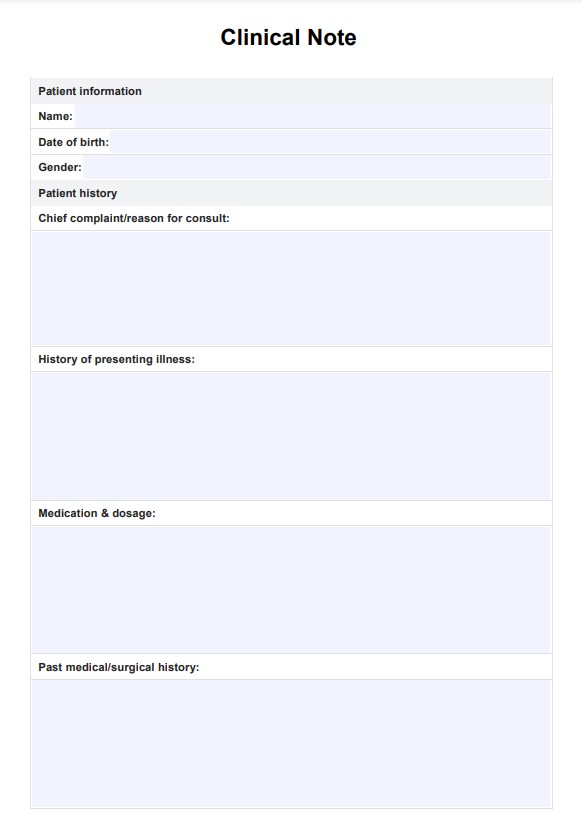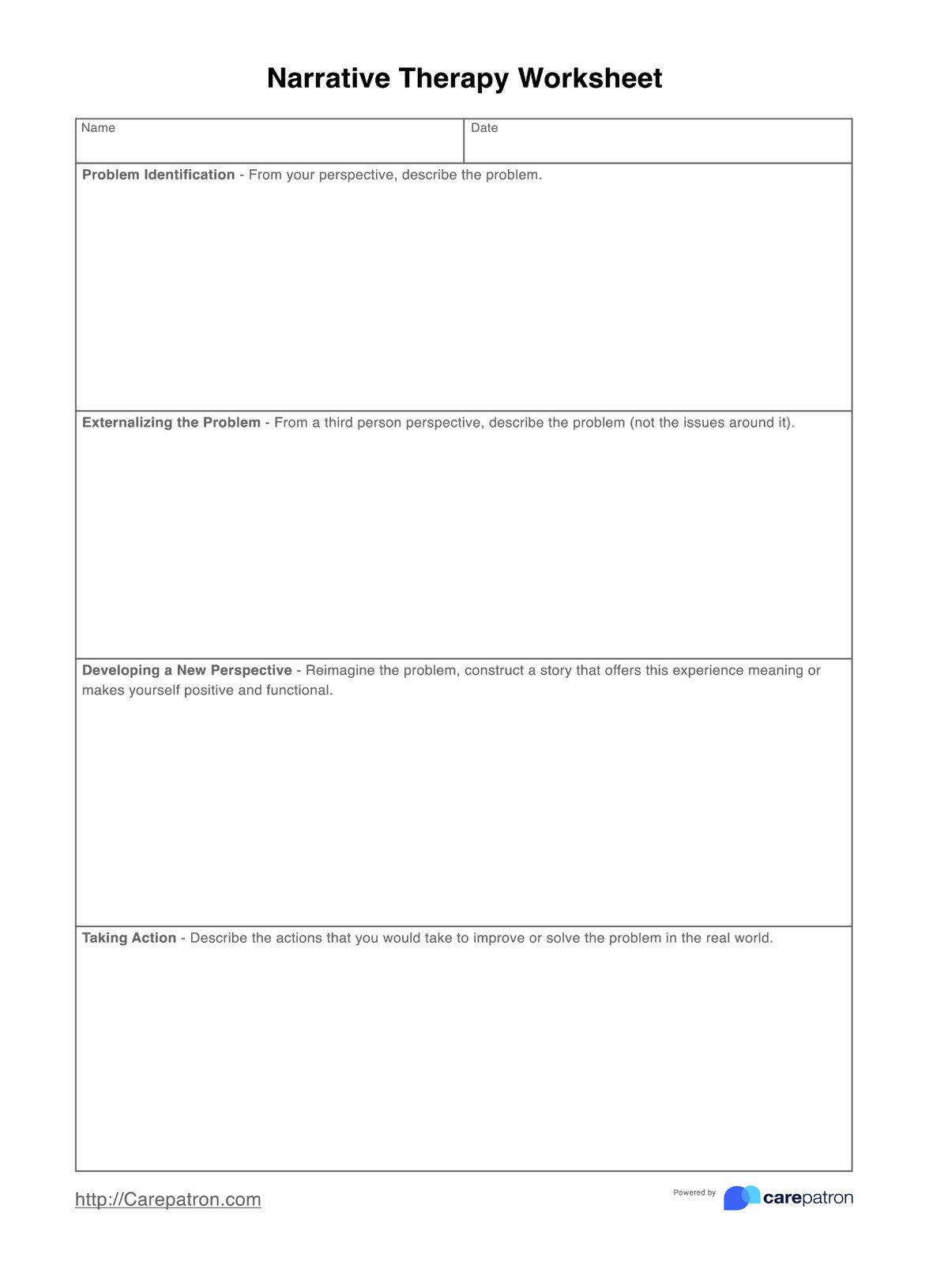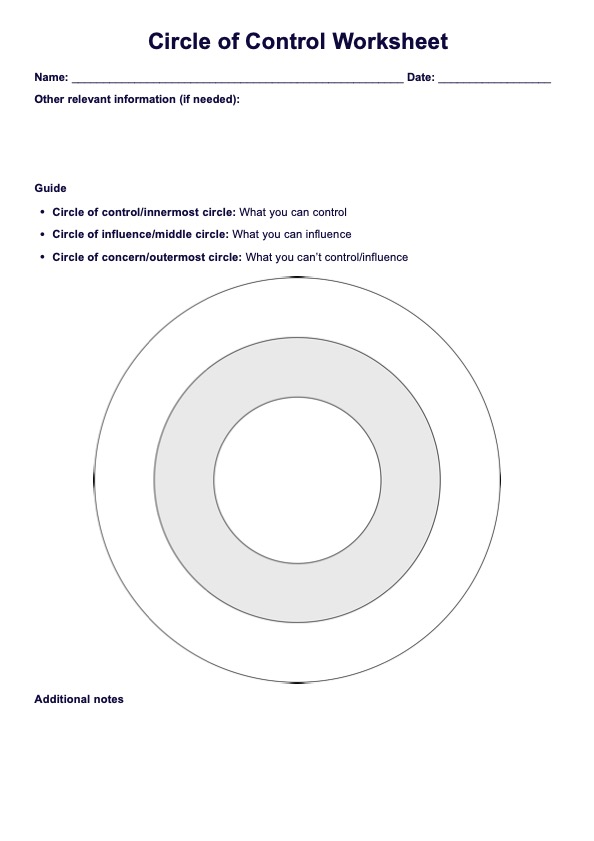General Health Questionnaire (GHQ-28)
The General Health Questionnaire (GHQ-28) is a useful screening tool you can use to evaluate your patient’s overall well-being and assess the level of psychological distress they could possibly be experiencing.


What is the General Health Questionnaire (GHQ-28)?
The (GHQ-28) is a valuable mental health instrument created by British psychologist David Goldberg. This particular tool was designed to be a screening tool for patients consulting with professionals about their mental health. This tool specifically assesses a patient’s overall well-being and the level of psychological distress they are experiencing.
This questionnaire is an expanded version of the General Health Questionnaire (GHQ-12). The GHQ-12 version only has twelve questions while the GHQ-28 has twenty-eight. The questions for both versions focus on a patient’s recent experiences and feelings that may be the result of mental health problems like the loss of confidence and self-worth, depression, anxiety, and stress. The GHQ-28 also asks about physical issues that may be the result of their psychological distress, like feeling headaches and hot or cold spells.
The GHQ-28 is not able to pinpoint the specific factors that contribute to a patient’s psychological distress. Rather, the patient’s answers on the test should serve as points for discussion for later sessions. Having them expand on their answers should help you identify what is causing and/or contributing to their distress as well as other mental health-related issues they might have.
The GHQ-28, just like the GHQ-12, is not a diagnostic tool, so do not use it to diagnose patients with specific mental illnesses. Once you (or a specialist) have officially diagnosed a patient after conducting comprehensive examinations, you may use this questionnaire to monitor them down the line to check for any changes in their condition.
General Health Questionnaire (GHQ-28) Template
General Health Questionnaire (GHQ-28) Example
How to use the General Health Questionnaire (GHQ-28)
Administer the questionnaire to your patient!
Administering this questionnaire is easy, and you can choose between two ways to do so!
The simplest way is to hand the patient a copy of an unanswered questionnaire and have them answer it. You can do this during an actual appointment or as something for them to take home/do on their own time.
Or, you can conduct it like an interview where you can ask them these questions and provide them with the set answers they can give per question.
Whichever you choose as your preferred way to administer it, all the patient has to do is answer each question by selecting one out of four possible answers. They simply need to select based on how the answer applies to them in the context of what is being asked. The answer sets are usually the following listed below:
- Not at all
- No more than usual
- Rather more than usual
- Much more than usual
Some questions are framed positively, so the answer sets for those are the inverse of what is listed above.
Calculate the scores and, if needed, recommend the patient for further evaluation.
The scoring scheme for this is the same as the GHQ-12, but for the benefit of those who aren’t aware of this system, each question can score between 0-3. The answer sets for each question are arranged by severity from left to right, with the leftmost answer (the first choice) being equivalent to a 0 and the rightmost answer (the last choice) being equivalent to 3 points.
Given that there are twenty-eight questions and the highest possible score per question is 3, the maximum score for this questionnaire is 84.
Unlike other assessments that are used to gauge patients, there are no specific score ranges to refer to. What you need to keep in mind is that the higher the patient’s score is, the more likely they are experiencing psychological distress at a level that is concerning.
Even if there is no score range to refer to, you have their specific answers to look at. If their answers score a 2 or 3, and they answered a lot of questions that got those same scores, well, they definitely need to undergo a more comprehensive examination.
You may even use their answers as points of discussion so they can elaborate on what they feel during subsequent sessions. If they are able to expand on their answers, you will be able to get a better picture of them, which should help you make more informed decisions as you go about treatment.
When does one typically administer the General Health Questionnaire (GHQ-28)?
The best time to administer the General Health Questionnaire (GHQ-28) is during mental health consultations, especially during the early stages of a patient’s treatment.
Let’s make an example so you know why the earliest sessions are the best times to use this questionnaire.
Let’s say you have a patient who scheduled their first-ever mental health-related appointment with you. Your goal is to talk to the patient and get to know them so you know how they generally feel about themselves. But that is easier said than done because mental health is a touchy subject for most people and it’s hard to open up, even to a specialist.
To help them open up to you, you should issue the GHQ-28 questionnaire. If you are opting to have the questionnaire taken home, make sure to come to an agreement as to when they should submit it.
The questionnaire does not ask for elaborate answers, but you can. You can base your questions on the answers that they picked for each question in order to nudge them to explain things to you. The more (specific) information you are able to get, the better the picture you will have of them. And the better the picture you have of them, the more well-rounded and better-informed your perspective and decisions will be when it comes to developing a treatment plan.
The use of this questionnaire isn’t just a one-time thing, though. You may also reuse this down the line once they are already undergoing the treatment plan you created for them. Reusing this questionnaire will help you gauge your patient for any improvements related to their psychological distress.
Who normally uses the General Health Questionnaire (GHQ-28)?
The General Health Questionnaire (GHQ-28) is often used by a wide variety of healthcare professionals who specialize in dealing with and treating psychological/mental health issues, like the following:
- Psychologists
- Psychiatrists
- Counselors
- (Mental health) therapists
- Primary care physicians
But the questionnaire does not just benefit the types of professionals that treat patients. Even researchers and psychometricians can find this questionnaire to be a useful tool to evaluate the effectiveness and reliability of treatment plans, interventions, and even the tool itself!

What are the benefits of using the General Health Questionnaire (GHQ-28)?
The GHQ-28 is simple and easy to accomplish!
Anyone who includes this questionnaire in their roster of screening tools may find it to be beneficial in the sense that it saves time, mainly because the questionnaire has general questions and has set answer choices per question, so accomplishing it will not take long.
Yes, it is far longer than the GHQ-12, so it would only take a little more time to finish this compared to the GHQ-12, especially if the patient really takes their time to reflect before answering the questions.
It’s a great tool to detect psychological distress in a patient as early as possible.
Since the GHQ-28 is typically used during the earliest sessions that healthcare practitioners have with their patients, the questionnaire is a wonderful instrument that can help identify a person’s level of psychological distress as early as possible. By assessing their patients early, professionals will be able to take action immediately by conducting the necessary examinations, diagnosing patients (if needed), and implementing treatment plans.
Of course, what could hinder this is the patient not opening up about their mental health. This is where the tool could help because knowing what the patient is generally feeling can lead the professional to ask follow-up questions that encourage patients to elaborate. The more information you have, the better because you will be able to have a more well-rounded opinion about your patient, which will be beneficial when conducting further examinations and developing a treatment plan.
It can be used to monitor both your patient and your treatment plan.
Let’s stipulate that you have made significant process when it comes to treating your patient. You have already gone through the sessions where you administered this test and got more information about the patient regarding their emotions. You have also conducted a more comprehensive examination so you were able to make an official diagnosis, plus implement a treatment plan.
If you are curious as to how they have been doing after implementing the treatment plan, you can reissue this questionnaire to see if there are any significant changes regarding their psychological distress. Are they getting better? Worse? Or are they still the same?
At the same time, you will be able to monitor if your plan is working or not. If they are getting better, then you ought to maintain your plan. If not, then there’s probably something that isn’t working, so you might have to adjust or replace components of your plan.
Commonly asked questions
Yes and no.
Yes, because you will be relying on your patient’s answers. Their answers on the questionnaire reflect what they feel and how terrible the level of their psychological distress must be. The questionnaire does not actually pinpoint anything for you, but it does set the groundwork for you to get more information. Your patient's answers should serve as discussion points for you to get more elaborate answers.
No, because it is a general questionnaire. Given its nature, using it might not be enough when it comes to assessing your patient, which is why we recommend that you check out our platform for other psychology and mental health-related tools to help you cover numerous angles and consider different perspectives.
Yes. Let’s say that you are not a healthcare professional and you somehow stumbled upon this guide and questionnaire. You may use it to assess yourself, but please DO NOT self-diagnose or make decisions based on your score except for seeing a professional. So, if you do score high, go see a professional for further evaluation.
It’s up to you. You can even use both if you want. Though, since covering more ground is something that any mental health professional should always consider, we recommend using the GHQ-28 since it asks more questions, therefore it covers more aspects of a person in terms of their well-being.


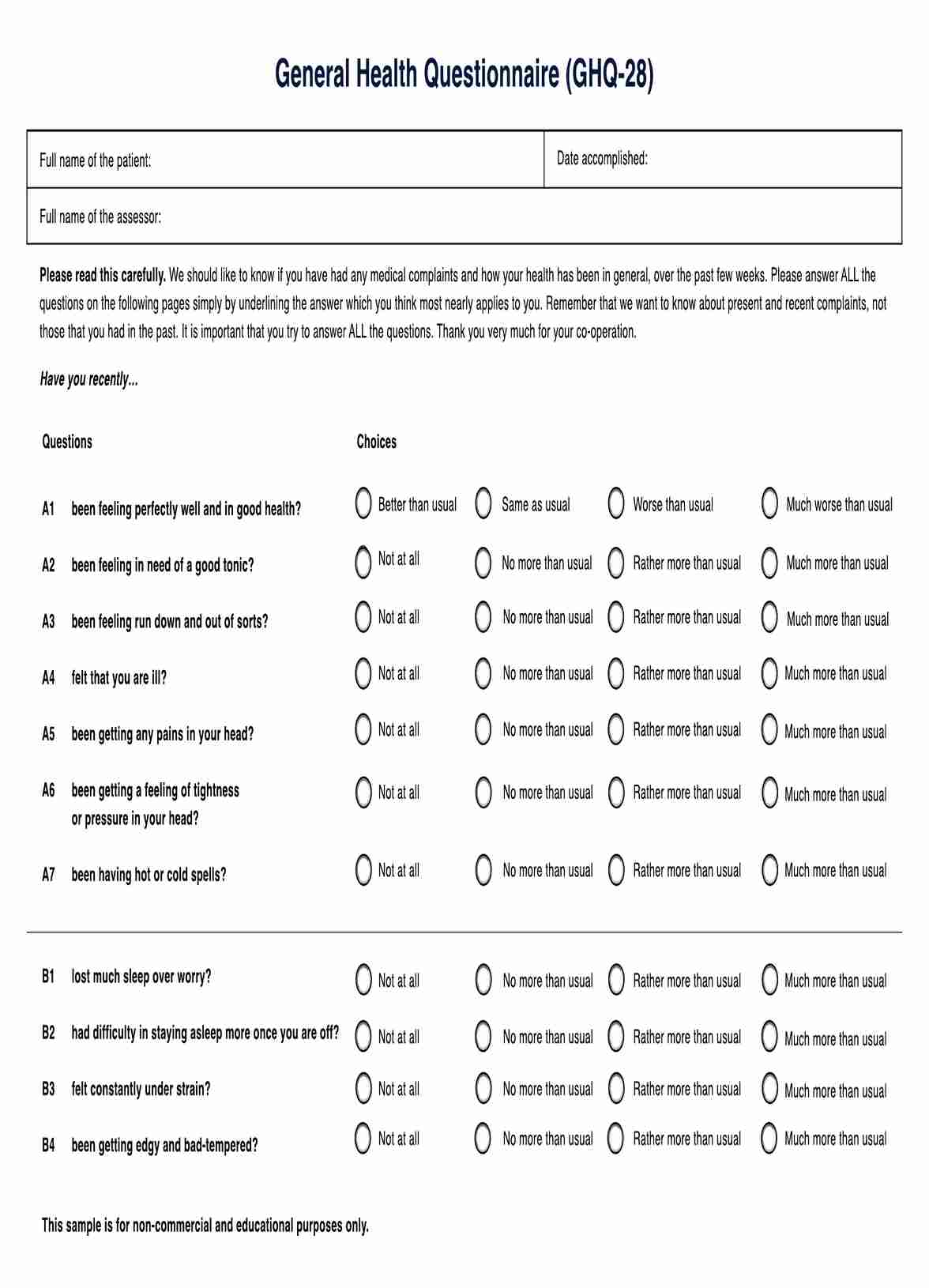
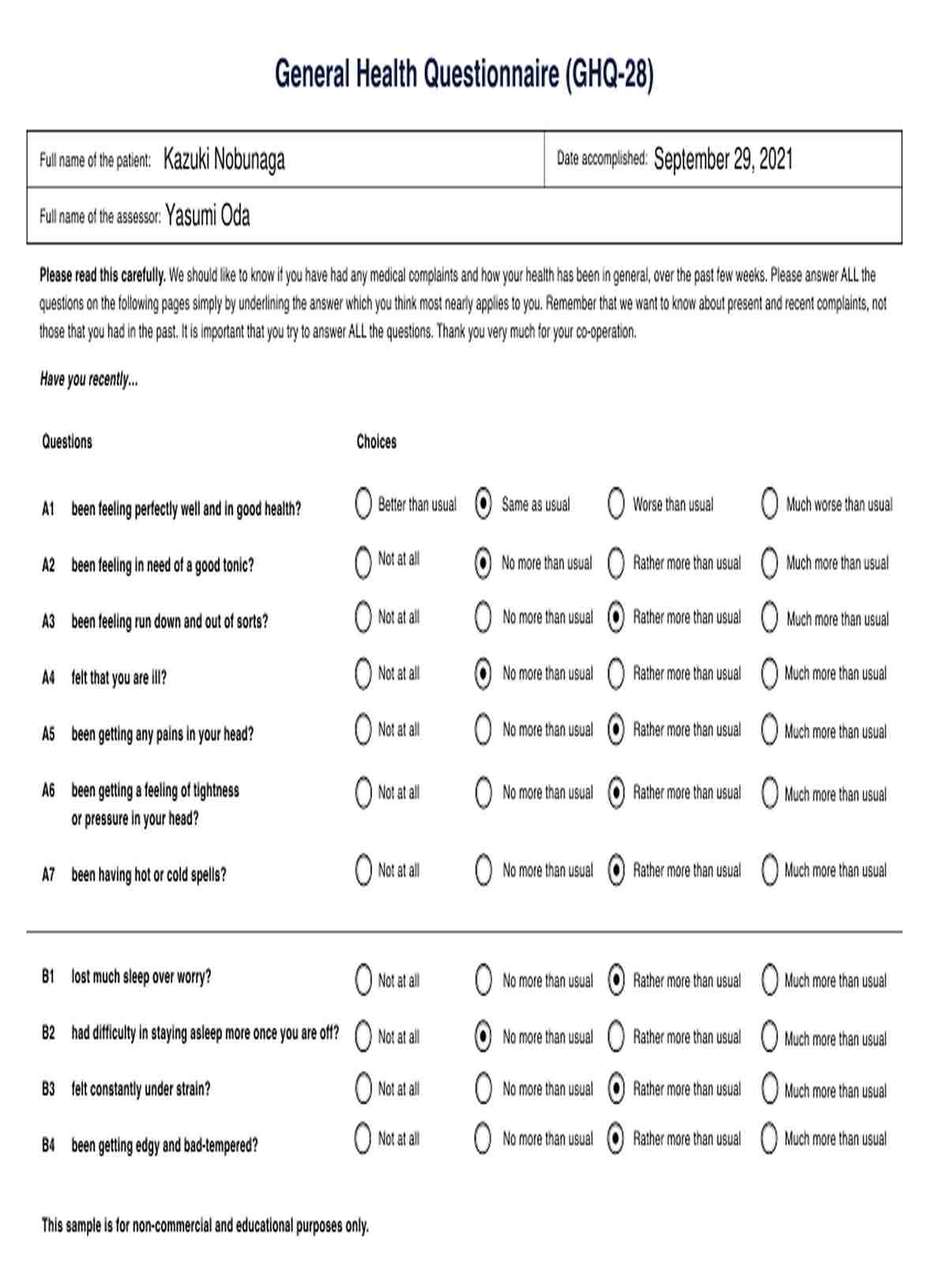













-template.jpg)






























































































